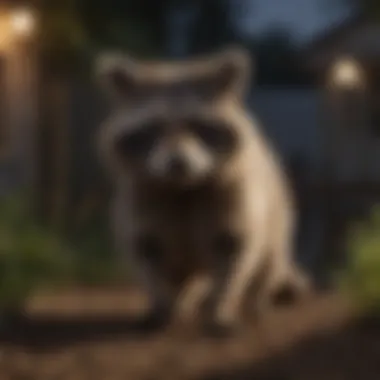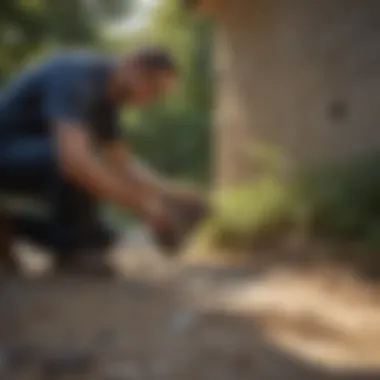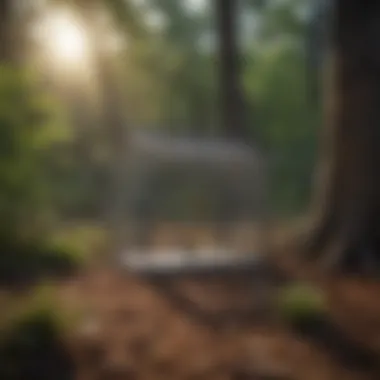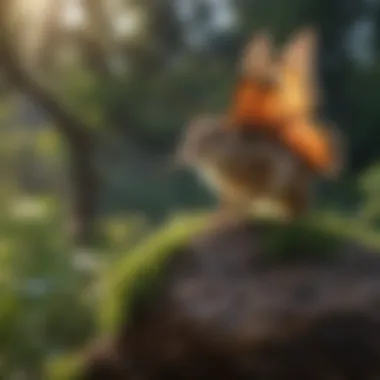Comprehensive Guide to Critter Removal in Austin


Intro
In urban areas like Austin, it is common for homeowners to encounter various forms of wildlife. These critters can often become unwelcome guests within our living spaces. Understanding how to manage these encounters is crucial for maintaining a healthy and safe environment. This guide aims to equip homeowners with the necessary knowledge and tools for critter removal. It delves into effective strategies, preventative actions, and legal considerations that should be kept in mind.
Understanding Pests
Definition of Pests
Pests refer to animals and insects that cause disruption or harm to human activities, particularly in residential areas. In Austin, some commonly encountered pests include raccoons, squirrels, opossums, and various rodent species. These animals often seek shelter, food, and warmth, inadvertently leading to conflicts with homeowners.
Importance of Pest Identification
Correctly identifying the critters is essential. Different species require unique management strategies. For instance, a squirrel in the attic may necessitate a different approach than a raccoon raiding the trash. Misidentification can lead to ineffective solutions, prolonged issues, and even legal ramifications. Homeowners must observe signs of infestation such as droppings, tracks, or noises at night. By tracking the specific behavior, one can initiate appropriate actions.
Prevention Techniques
Home and Garden Preventative Measures
Preventing critter entry starts with securing your home. This involves basic modifications around the property:
- Seal Entry Points: Inspect the exterior of your home for gaps, cracks, or holes, especially around roofs and basements. Closing these holes can deter critters from entering.
- Remove Attractants: Keep food sources inaccessible. Store pet food in sealed containers and ensure that trash bins feature tight-fitting lids. Falling fruit from trees can also attract unwanted visitors.
- Maintain Landscaping: Trim back bushes and trees that could serve as pathways. Keeping shrubs short and far from windows can make it harder for critters to access your home.
Seasonal Prevention Tips
As seasons change, so do the habits of these pests. To stay proactive:
- Spring and Summer: Regularly check and maintain gutters to avoid stagnant water attracting insects. This is also the time to clear away debris and dead plants that might harbor pests.
- Fall: Inspect homes for potential entry points. As the weather cools, animals often seek warmth inside buildings. Fall is also a time to cover vents and utility openings.
- Winter: Ensure heating systems are checked, as the warmth from homes can be an inviting factor for critters.
Eco-Friendly Pest Control Solutions
Overview of Sustainable Practices
Utilizing sustainable practices in critter removal is crucial for minimizing ecological impact. Strategies include:
- Humane Traps: Using live traps allows for the relocation of animals without harming them.
- Natural Repellents: Certain scents like peppermint oil or vinegar can be effective deterrents for many pests without resorting to harmful chemicals.
Natural Remedies and Their Effectiveness
Many homeowners are shifting toward effective natural remedies to manage pests. For instance, using a mixture of water, dish soap, and oil can help deter insects. Applying these mixtures to affected areas can provide a balanced, eco-friendly solution that poses little risk to the surrounding ecosystem.
"Incorporating humane methods into pest management not only helps homeowners maintain their properties but also fosters greater respect for wildlife."
By leveraging the insights offered in this guide, homeowners can better navigate the complex world of critter removal, making informed decisions that benefit both their homes and the environment.
Understanding the Need for Critter Removal
Understanding the necessity of critter removal in urban areas like Austin is crucial for homeowners. Critters, including various wildlife species, can pose significant risks to both property and health. Their presence often leads to damage in homes, potentially costing more in repairs than one would expect. Moreover, they can also be carriers of disease, exposing residents to health hazards.
Addressing the critter issues before they escalate can save homeowners a lot of stress. Recognizing the signs of an infestation early can lead to quicker interventions. In addition, comprehending the ecological role of these animals is important. While critters can be nuisances, they also contribute to the ecosystem. Therefore, effective management strategies need to balance removal with the responsibilities of ethical stewardship.
The benefits of proper critter removal practices extend beyond mere eradication. They include preserving property values, ensuring safety, and maintaining an organized living environment. Proper understanding leads to informed decisions. This insight enables homeowners to select the right service providers and choose humane removal methods, which are essential in managing wildlife responsibly.
Definition of Critters
Critters refer to a variety of small animals often found in residential and urban settings. This term encompasses many species, including mammals, birds, and insects. In the context of this article, critters mainly include animals that can create disturbances for homeowners. Understanding what constitutes a critter helps in identifying potential issues around the home.
Common Critters in Austin
Raccoons


Raccoons are notorious for their mischievous behavior, often rummaging through garbage. Their ability to open containers and doors makes them particularly troublesome. This unique feature, while fascinating, results in significant property damage. Raccoons contribute to the overall topic by demonstrating the need for secure waste management and exclusion techniques.
Possums
Known for their play-dead defense mechanism, possums can appear unthreatening. Their diet includes pests like ticks, which is beneficial for gardens and yards. However, they can occasionally cause issues when nesting in attics or under houses. Understanding the dual nature of possums helps homeowners make informed choices about their management.
Rodents
Rodents, such as mice and rats, are among the most common critters found in homes. They reproduce rapidly, leading to significant infestations quickly. Additionally, they can carry diseases that pose health risks. Their ability to squeeze through tiny openings underlines the necessity for preventative measures in critter management.
Bats
Bats play an essential role in controlling insects, but their presence in homes can lead to issues. They prefer dark, sheltered areas for roosting, which can cause unsanitary conditions. Their presence indicates the need for humane exclusion measures to remove them without harm. Understanding bats helps shape effective strategies for pest management.
Squirrels
Squirrels are not typically viewed as harmful, yet they can cause significant issues. They often access attics and crawl spaces to build nests, leading to structural damage. Moreover, squirrels can chew through electrical wiring. Recognizing these behaviors helps homeowners understand the potential risks associated with having squirrels nearby.
Signs of Infestation
Physical Evidence
Physical signs of infestation include droppings, tracks, and nests. These indicators provide tangible evidence for homeowners to identify which critters might be present. Distinct markings can help in targeting removal efforts. Recognizing such physical clues can expedite action before conditions worsen.
Sounds and Noises
Hearing unusual sounds, such as scratching or rustling, at night can indicate a critter issue. Monitoring these sounds is critical, as it often reveals hidden infestations. Sounds provide an immediate insight into the activities of critters and can guide timely interventions.
Visual Sightings
Spotting a critter in your living space is one of the most obvious signs of an infestation. Sighting can prompt immediate action from homeowners. However, understanding the behaviors and habits of these animals can provide better context for effective removal strategies.
Eco-Friendly Critter Management
Managing critters in an eco-friendly way is crucial in maintaining a balance in the local ecosystem. It minimizes harm not only to the animals but also to the environment. Instead of causing injury to unwanted wildlife, eco-friendly techniques aim to gently and humanely remove critters while preserving the natural habitat they call home. This approach is gaining traction among homeowners who are increasingly aware of the environmental implications of their actions.
Humane Removal Techniques
Live Trapping
Live trapping is a method that involves capturing critters without causing them physical harm. This technique is characterized by its ethical approach. Homeowners appreciate it because it allows for the safe relocation of animals. The unique feature of live trapping is that it uses specially designed traps to catch creatures and keep them unharmed.
One significant advantage of live trapping is its humane nature, which resonates well with many residents in Austin who prefer not to harm animals. However, it is essential to check local regulations regarding relocation practices, as some areas have specific rules about where trapped animals can be released.
Exclusion Methods
Exclusion methods focus on preventing critters from entering living spaces in the first place. The key characteristic of this technique is its proactive approach to critter management. By identifying potential entry points and sealing them off, homeowners can effectively keep wildlife at bay.
This approach is favored because it does not require the removal of animals after they invade. It addresses the root cause of the problem. One unique feature of exclusion methods is that it often involves long-term solutions such as repairs to buildings and landscaping alterations. While exclusion methods need upfront investment, they can save homeowners from the hassle and costs of dealing with animal invasions later.
Preventive Measures
Sealing Entry Points
Sealing entry points is a critical preventive measure in critter management. It involves identifying potential access points and eliminating them to stop critters from gaining entry. The core advantage of this method is its effectiveness; a sealed home is less likely to experience wildlife intrusion. Homeowners usually find sealing entry points a simple yet powerful solution.
Moreover, this method involves various techniques such as caulking gaps, installing door sweeps, and reinforcing vents. Its unique feature is that it can be implemented as a DIY project, allowing homeowners to take control of their living spaces without significant expense.
Proper Waste Management
Proper waste management is vital in discouraging wildlife from infesting homes. The focus here is on maintaining cleanliness and securely storing garbage to prevent critters from being attracted. One advantage of waste management is that it addresses the food source that draws critters in the first place.


This method often involves utilizing bins with secure lids and ensuring that food waste is disposed of regularly. Proper waste management is not only beneficial for critter control but also promotes a cleaner and more sanitary environment overall. A unique feature is that community awareness about waste management can lead to widespread improvements in critter control strategies throughout Austin, benefiting everyone in the area.
Legal Perspectives on Wildlife Removal
Understanding the legal framework of wildlife removal is crucial for residents facing critter issues in Austin. Wildlife is protected by various state and federal laws, and engaging in removal without proper knowledge can lead to legal penalties. Therefore, comprehending these legal perspectives not only safeguards homeowners but also ensures responsible treatment of wildlife.
With a balance between ecological integrity and human needs, the legal regulations guide how to approach critter issues responsibly. Failure to adhere to these laws can complicate removal efforts, leading to community disputes or even fines. Thus, familiarity with permits and protected species regulations is an essential step in ensuring that critter management is both effective and lawful.
Permits for Removal
In Texas, permits can be necessary for removing certain types of wildlife. The Texas Parks and Wildlife Department administers these permits. Not all critters require a permit for removal, but many do, especially those classified as fur-bearing or game animals. For instance, if homeowners are dealing with raccoons, a specific permit may be needed due to their protected status.
Getting a permit involves a straightforward process, generally requiring that individuals document the presence of the critter and the need for removal. This process also often entails understanding the timing and specific methodologies of removal. Without the proper permits, one may face legal ramifications, which includes fines.
Protected Species Regulations
Protected species regulations serve to shield certain wildlife from harm and unjust treatment. In Texas, a variety of species are protected under state laws, which includes many native birds and certain mammals. Understanding which species require protection is key to legal wildlife management. For example, bats are classified as a protected species due to their role in the ecosystem.
Before undertaking removal actions, it is critical to evaluate the species in question. Some may have breeding seasons that legally prohibit removal during specific times of the year. Ignoring these regulations can lead to severe fines and ethical implications. Therefore, homeowners should consult with local wildlife agencies or wildlife management companies familiar with these protections.
"Legal compliance in critter removal not only helps in preventing fines but ensures that humans and wildlife coexist respectfully."
Choosing Professional Services
Choosing professional services for critter removal is an essential step for homeowners dealing with wildlife issues. A pest expert can provide insights into critter behavior, recommend appropriate removal techniques, and ensure that the services comply with local regulations.
Additionally, having a professional handle critter situations can minimize health risks associated with contaminants. It is paramount to select a service provider that understands the local environment and specific challenges it presents.
Criteria for Selecting a Service Provider
Experience and Credentials
When it comes to critter removal, experience and credentials of the service provider are critical. Professionals with years of experience typically have faced a wide range of situations and know how to handle them effectively. A key characteristic of experienced providers is their ability to identify different critter species and their specific behaviors. This expertise allows for more efficient and targeted elimination methods.
A unique feature of such experience is the capability to devise prevention strategies based on previous infestations. While a newly established company may rely on the latest techniques, established businesses bring a historical perspective that is often beneficial in anticipating future problems.
Customer Reviews
Customer reviews offer significant insights into the quality of a service. They reflect real experiences of others who have used the services. Reviews can indicate how satisfied previous clients were with the removal process, pricing, and follow-up services. A favorable review trend is a good sign of reliability and effectiveness.
One distinct advantage of customer reviews is their ability to highlight specific strengths or weaknesses of a service provider. However, it is essential to consider the volume of reviews, as a few positive or negative reviews may not provide a comprehensive picture.
Eco-Friendly Practices
Eco-friendly practices in critter removal are increasingly gaining attention. Providers that focus on humane methods not only align with public sentiment but also ensure safer outcomes for both the homeowners and the critters. A key characteristic of eco-friendly practices is their reliance on non-lethal methods, such as live trapping and exclusion techniques.
This approach minimizes harm to wildlife and enhances the sustainable management of the local ecosystem. One disadvantage, however, may be that these methods can sometimes take longer than traditional removal techniques. Still, the long-term benefits often outweigh the immediate costs.
Cost Considerations
Understanding cost considerations is vital when selecting a critter removal service. Costs can vary widely based on several factors, including the severity of the infestation and the methods employed.
Initial Inspection Fees
Initial inspection fees typically cover a comprehensive assessment of the property. This step is crucial because it identifies the types of critters present and their entry points. A primary characteristic of these fees is their role in preventing further problems by providing a detailed plan of action.
However, some service providers may charge high inspection fees. It's essential to ensure that the inspection results in actionable insights rather than just data. This investment can often save money in the long run by preventing larger infestations.
Follow-Up Services


Follow-up services are often necessary after initial removal efforts. They may include additional inspections and preventive measures. The primary benefit of these services is that they provide peace of mind, ensuring that the problem does not recur. A key feature of these services is their tailored approach, adapting to the specific needs of each situation.
Although follow-up services can add to the overall cost, their importance in maintaining a critter-free home cannot be understated.
Case Studies in Austin
Case studies serve as a valuable tool in understanding the practical aspects of critter removal in Austin. They offer real-world examples that can inform best practices, highlight common challenges, and showcase the successes achieved through various techniques. This section focuses on the importance and benefits of case studies in critter management.
Successful Removal Stories
Successful removal stories illustrate that effective critter management is not only possible but also achievable with the right approach. For instance, a notable case involved a family in South Austin struggling with a raccoon problem. The homeowners noticed signs like overturned trash cans and nocturnal noises in the attic. They engaged a professional service that utilized humane trapping methods.
The raccoons were relocated safely, which allowed the family to regain peace of mind. This story emphasizes the significance of early detection and intervention. Such cases demonstrate that, with the right strategies, critter removal can be effective without harming the animals or the environment.
Additionally, these successful narratives help build trust within the community about professional services, showing that they can provide humane and effective solutions.
Challenges Faced
Removing critters can often encounter various challenges. These challenges highlight the need for community involvement and understand individual resistance to removal efforts.
Community Involvement
Community involvement plays a crucial role in overcoming challenges in critter removal. It fosters awareness and education regarding local wildlife. Neighborhood associations can organize events aimed at teaching residents how to identify critter problems and manage them effectively. This collective effort can lead to a reduction in infested areas and increase the success rate of removal strategies.
The key characteristic of community involvement is collaboration. Residents can share experiences and tips that aid in critter management. It can be a beneficial choice for management by leveraging local knowledge. Community events that focus on critter control encourage participation and ownership of the issue within neighborhoods.
However, mobilizing community involvement can present unique features that have both advantages and disadvantages. While it promotes awareness, some residents may resist participating due to mistrust or lack of interest. This resistance can create barriers to effective management strategies.
Individual Resistance
Individual resistance is another challenge in critter removal. Some homeowners may prefer to address wildlife issues on their own or refuse professional services entirely. This can stem from concerns over cost, skepticism about the necessity of removal, or emotional ties to the animals.
The key characteristic here is autonomy. Many individuals feel capable of handling issues, which can lead to varied outcomes. While some may succeed in managing minor problems, more significant infestations may escalate without professional intervention. Individual resistance can be a popular choice for some, prioritizing personal methods over expert guidance.
The unique feature of individual resistance often lies in the lack of comprehensive knowledge. This can lead to underground approaches that may not be effective or humane. Therefore, while some autonomy can be beneficial, it can also hinder the overall goal of effective critter management.
"Understanding local dynamics, including community involvement and individual behaviors, can significantly improve the effectiveness of critter removal strategies".
By acknowledging both successes and challenges, individuals can better navigate their options for critter removal. Engaging in community efforts while educating themselves about professional services can lead to more effective and humane outcomes.
Culmination and Best Practices
In the realm of critter removal, understanding the significance of best practices is paramount. This article has outlined various strategies essential for homeowners facing wildlife issues. Critter management is not merely about eradication; it encompasses a holistic approach focused on prevention and ecological balance. This balance is vital, as removing critters without addressing the underlying issues can lead to recurring problems, creating a cycle that is hard to break.
Key elements of a successful removal strategy involve knowing when to act and when to seek professional assistance. Many homeowners are unaware that personal attempts at removal can sometimes aggravate the situation or even violate local laws regarding wildlife protection. Hence, a well-informed approach also involves being conscious of the legal perspectives mentioned earlier.
Best practices in critter removal also emphasize the importance of sustainable methods. Eco-friendly measures ensure that the removal process does not harm the local environment or disrupt existing ecosystems more than necessary. By implementing humane removal techniques, homeowners can foster a safe living space for both themselves and the critters, respecting nature in the process.
To effectively manage critters, homeowners should:
- Regularly assess their property for potential entry points.
- Initiate preventive measures like proper waste handling and exclusion techniques.
- Stay updated on the local wildlife regulations to avoid unintended consequences.
Ultimately, critter management is about achieving a balance between protecting one’s property and maintaining harmony with the environment. Individuals equipped with knowledge about the critters around them, their habits, and how to deal with them effectively will find themselves in a stronger position to safeguard their homes.
Summary of Key Points
- Understanding Common Critters: Familiarize yourself with the types of critters in Austin and their behaviors.
- Signs of Infestation: Recognize the signs early to mitigate damage and health risks.
- Humane Removal Techniques: Engage in eco-friendly methods like live trapping to ensure critters are managed with care.
- Legal Considerations: Always consult local regulations to ensure compliance during removal.
- Prevention is Key: Regularly inspect and maintain your property to prevent future infestations.
Future Considerations in Critter Management
Towards the future, the landscape of critter management will evolve alongside the growing concerns over ecosystem health and urban wildlife interaction. As urban areas expand, wildlife will increasingly come into contact with humans. This means that knowledge and strategies will need to adapt accordingly.
Using technology to monitor critter activity may become more commonplace. Smart traps and monitoring devices can aid in tracking wildlife, thus allowing for informed decision-making. Advocacy for wildlife, coupled with education about nuisance species, will also be crucial. The community stands to benefit from understanding the role of certain critters in the local habitat, promoting coexistence rather than conflict.
Moreover, investing in continued education about non-lethal removal methods can further enhance humane practices. Workshops or community programs addressing wildlife issues could connect homeowners with experts, fostering a culture of understanding and respect for critters.
By prioritizing these considerations, the dialogue surrounding critter management can evolve, ultimately creating a balanced relationship between humans and the natural world.



